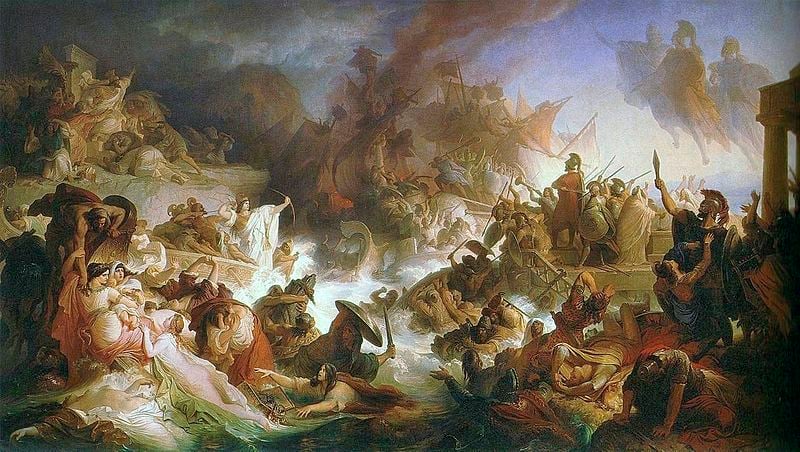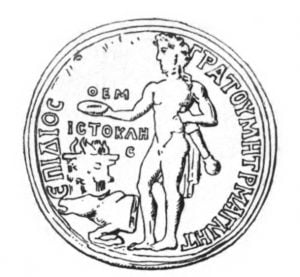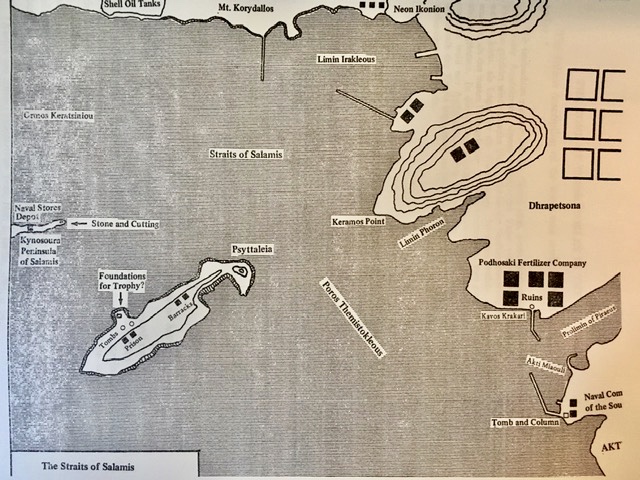
The truth is sometimes a difficult thing to be absolutely sure of when looking back on events which transpired in the glory days of ancient Greece. And this can be quite maddening to historians, who would give anything in the world to know the history behind each and every inch of soil in a country such as Greece.
The life of the great Athenian general Themistocles is fairly well known, as the low-born leader was lauded even in his time for his brilliance in the battles against the Persians at Salamis and Marathon.
However, the place of the great general’s burial has been the source of confusion for centuries. Historian Paul Wallace, from Dartmouth College, says that the writer A. W. Gomme suggested that the name of Themistocles was first associated with a promontory, leading to that place being thought of as the location of his tomb.
Gomme inferred this from the writing of Plutarch. The great historian wrote of a man known to history as Diodorus the Traveler: “And Diodorus the Traveler in those about the monuments said, as a hint rather, or knowingly, that about the port of Piraeus, from the cape according to Alkimon, it is like elbows. Bending it inside, or the one in charge of the sea, a creek and about it an altar, the tomb of Themistocles.”
“Once the name of Themistokles was firmly associated with a promontory,” Wallace says, “a myth could quickly develop that the promontory was so called because his bones were buried there.”
He goes on to state that Athenians would be happy to go along with this belief, believing that the presence of a grave of the great military man would do nothing but enhance the status of the city as a great military power.

The eminent painter of Greek antiquities and monuments Edward Dodwell, who visited this site in the 1800s, said:
If indeed we could identify this as the sepulchre of the great man, by whose energetic valour, and commanding genius, Xerxes was subdued, it would be one of the most interesting monuments in Greece. And what locality could be more appropriate for the reception of his venerable ashes, than the same shore which had witnessed his triumph, and which still overlooks the Psytalian and the Salaminian rocks, and the whole extent of the Saronic gulf?

Themistocles’ Humble Beginnings
Themistocles, whose name means “Glory of the Law,” was born in approximately 524 BC and lived to 459 BC. Although low-born, unlike all the previous Athenian generals and rulers, he rose to prominence during a time when democracy was first being established in the city state.
A wily cultivator of the common people, Themistocles was a populist, often finding himself at odds with Athenian nobility. Known for his overweening ambition, Themistocles fought at the Battle of Marathon (490 BC) during the first Persian invasion of Greece. It may be possible that he was one of the ten Athenian generals in that battle under the great general Miltiades.
In the ensuing years, Themistocles rose through the circles of political power, becoming a prominent Athenian politician.
According to the historian Herodotus, “he wooed the poor; and they, not used to being courted, duly loved him back. Touring the taverns, the markets, the docks, canvassing where no politician had thought to canvas before, making sure never to forget a single voter’s name, Themistocles had set his eyes on a radical new constituency.”
He began to practice law and is known as the first person in Athens to prepare for public life in this way. His ability as attorney and arbitrator, employed in the service of the common people, won him over to his constituents even more.
However, cunning politician that he was, he took care to make sure that he did not alienate the nobility of Athens.
By the time of the second Persian invasion, he had persuaded Athens to secure the building of 200 triremes, which proved to be crucial in the upcoming Greek victories of Artemisium and Salamis, in 480 BC.
Later becoming ostracized and fleeing Greece after his perceived arrogance made him widely unpopular, Themistocles entered the service of the new Persian emperor, Artaxerxes. He was then made governor of the province of Magnesia, a title which he retained until his death.
Rehabilitation and Reburial?
It is possible that he was buried in Magnesia, but he was rehabilitated by the Athenian political elite. This fact has led many to believe his body came to be buried near Athens perhaps near the Saronic Gulf in a place not far from his greatest victories.
The great historian Thucydides eulogized Themistocles as “a man who exhibited the most indubitable signs of genius; indeed, in this particular he has a claim on our admiration quite extraordinary and unparalleled.”
The historian Plutarch described him as “the man most instrumental in achieving the salvation of Greece.”
His unshakeable belief in the importance of a strong naval force made an indelible impression on Athenians for centuries to come since naval power became the hallmark of the Athenian empire and the golden age of its civilization.

As earlier noted, it had been rumored since the times of Thucidydes that the great, forward-thinking general had been reburied at the southern entrance to Piraeus, on the Akti peninsula near Akti Miaouli. During Turkish times, travelers corroborated the fact that there was indeed a great stone tomb there and it was commonly referred to as “Themistocles’ Tomb.”
In 1970, historian Paul Wallace visited the site and took these photos and then shared his writing on the subject at a meeting of the American School of Classical Studies at Athens. In 1952, a nine-meter tall column was reconstructed from blocks which had collapsed through the ages and several other ashlar blocks also appear to mark a grave site there.

In what would appear to be a slam-dunk for historians, there is indeed an inscription on a stone in the second course of the west wall which says “ΘΕΜΙΣΤΟΚΛΕΣ ΝΙΚΟΛΕΟΣ ΦΡΕΣΤΤΙΟΣ.” Wallace says “The great statesman’s descendants must have known that he would not take offense if they misremembered his father’s name.”
However, another site, in Drapetsona on the promontory just 800 meters to the north of Akti known as Kavos Krakari is also purported to be the actual site of the grave. Described by the archaeologist Iakovos Dhraghatsis in the early 1900s, this site comprises several columns and a round stone at the base.
Dhraghatsis held that this, unlike the more southern location, is the final resting place of Themistocles since it would hold just individual bones unlike the Akti grave which would have been meant for an entire body buried just after death.
Unfortunately, this area was in Dhraghatsis’ time the site of the Podhosaki Fertilizer Company, which Wallace says laconically “does not display the antiquities to best advantage.”
“Time,” he goes on, “and the fertilizer company have raised the ground (now a pavement) around the structure approximately 2.0m higher, and the buildings of the Company make surface exploration in the area impossible. But at least the site of the antiquities is no longer used by the Company as a trash dump, as in the days when it roused Dhraghatsis’ ire.”
According to reports, the northern site was sold at a great profit to the chemical company in the early 1900s despite the Greek government being aware that this was the final burial spot for the general. It was only then that the more southern site was touted as the correct burial place.
After decades of the fertilizer company’s operation, it finally went bankrupt and ceased operations in 1999. However, in 2014, a group of history buffs who want to ferret out what exactly took place on that piece of land took action.

In hopes that they would spur the government to undertake a process to secure the necessary permits to research and protect he area, they erected a stone column in a ceremony marking the spot on the company’s land where they believed Themistocles’ bones lay.
However, there has been no further development on the issue since that time, and despite the emplacement of the column and its attendant ceremony, the secrets of history remain in the earth in Piraeus.
Perhaps at some future time, the truth will come out and this great Athenian general will finally be given the honor that he is due with an official burial site that is as grand as befits a great statesman and one that will be protected forever.
Battle of Salamis: The First Great Naval Battle in History
If some brave Greeks hadn't defeated the Persians 2500 years ago, it would have been the end of Greece as we know it and the world would have never been the same. Full story: https://bit.ly/2QKMbrb
Posted by Greek Reporter on Sunday, April 26, 2020
See all the latest news from Greece and the world at Greekreporter.com. Contact our newsroom to report an update or send your story, photos and videos. Follow GR on Google News and subscribe here to our daily email!



